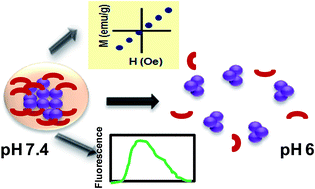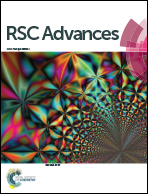Multimodal theranostic nanomaterials derived from phthalocyanine-based organic salt†
Abstract
Emerging concepts of theranostics have led to the development of numerous multifunctional nanomaterials using various synthetic approaches. Herein, we report a simplistic approach towards the design of iron(III) phthalocyanine based pH responsive–magnetic–fluorescent nanoparticles for combined multimodal diagnosis and possible site selective therapy. Transmission electron micrographs (TEM) revealed distinct spherical (∼25–35 nm) nanoparticles, constituting a significantly stable nanodispersion which resulted from an appreciably high positive zeta potential (+21 mV) at pH 7.4. A transition in magnetic behavior of these nanoparticles (diamagnetism in bulk, paramagnetism in nanoparticles at room temperature and superparamagnetism at 200 K), in combination with acidic pH responsive loss of spherical shape, pH responsive release of chemotherapeutic agents in vitro, and confocal fluorescence microscopic images suggest potential utility of these materials as multimodal theranostic agents. A novel approach to the design of multifunctional theranostic devices, as demonstrated in this study, represents an important development in this area of scientific research.



 Please wait while we load your content...
Please wait while we load your content...